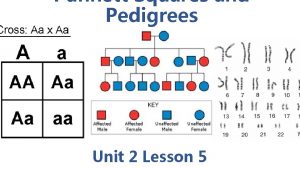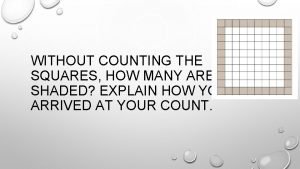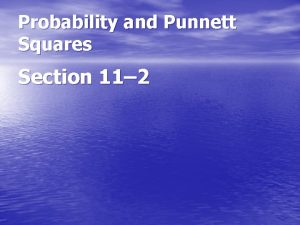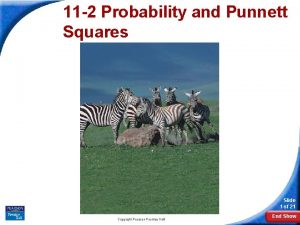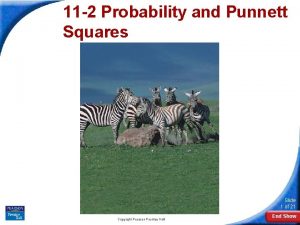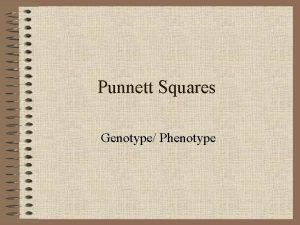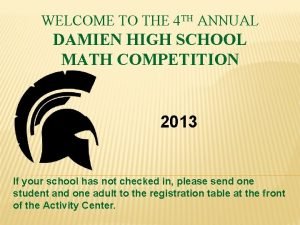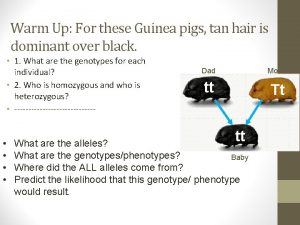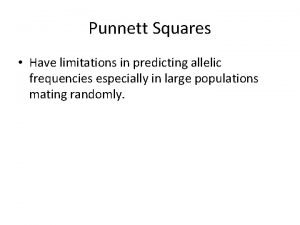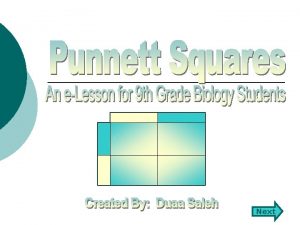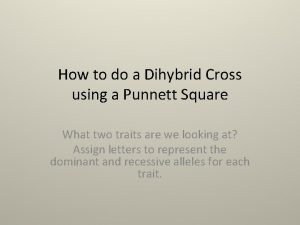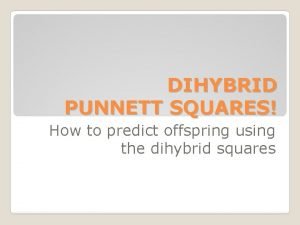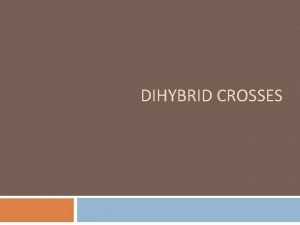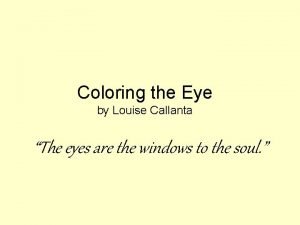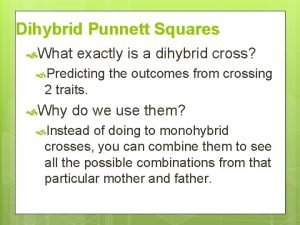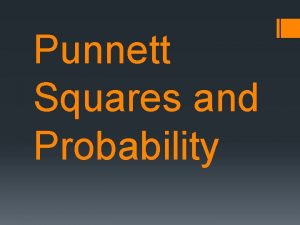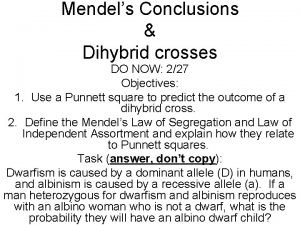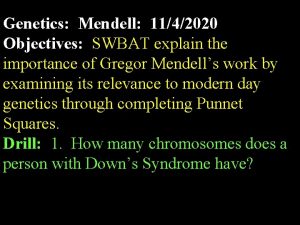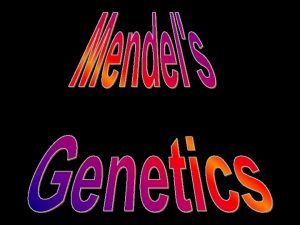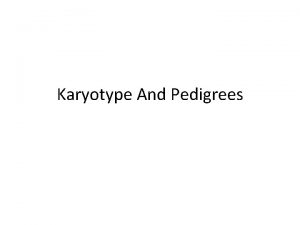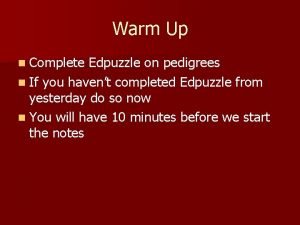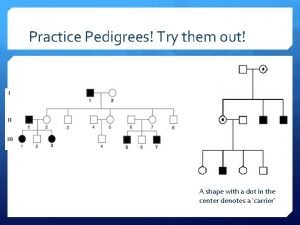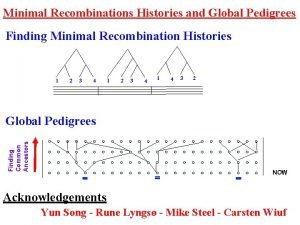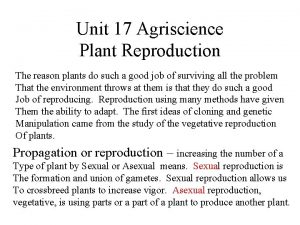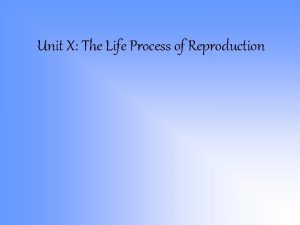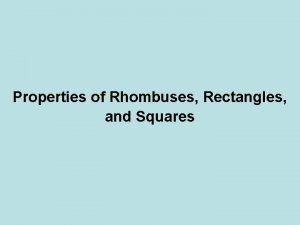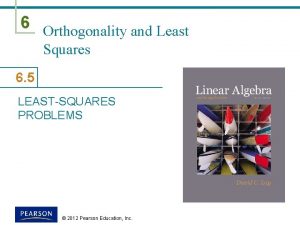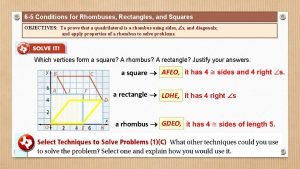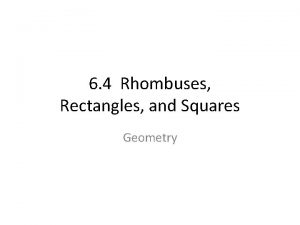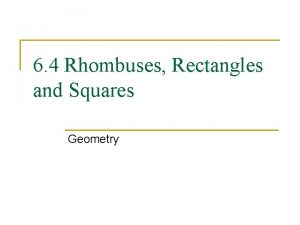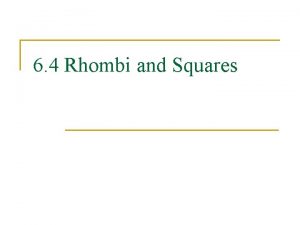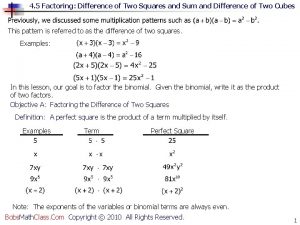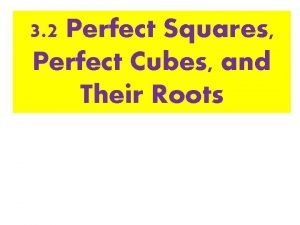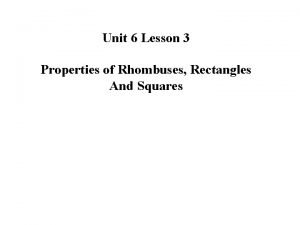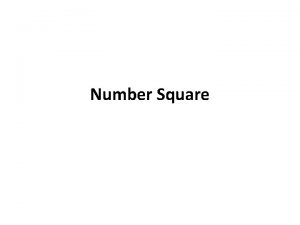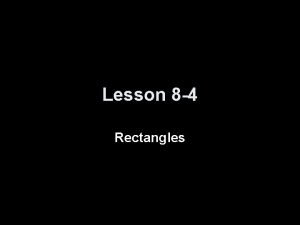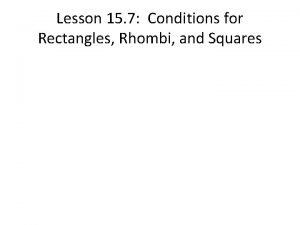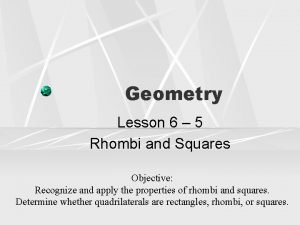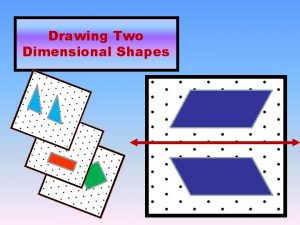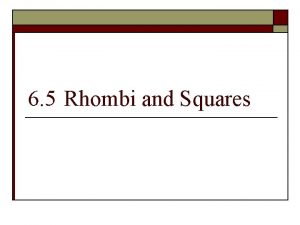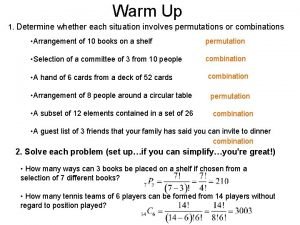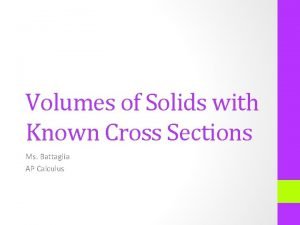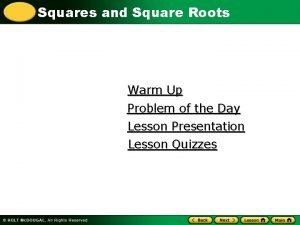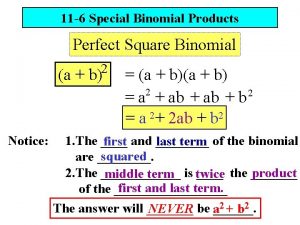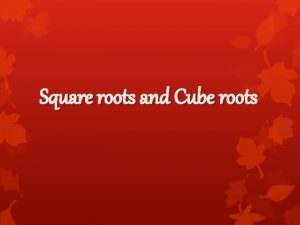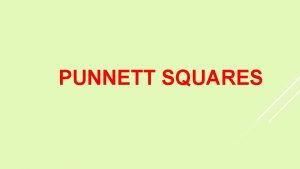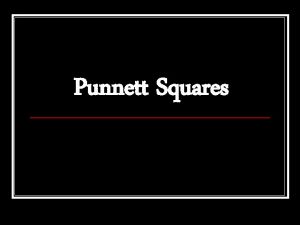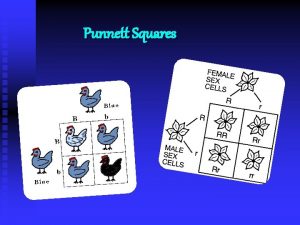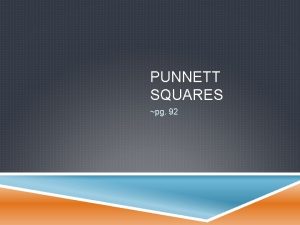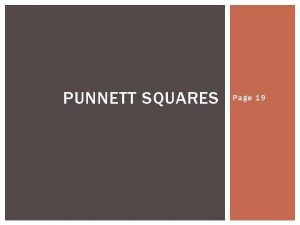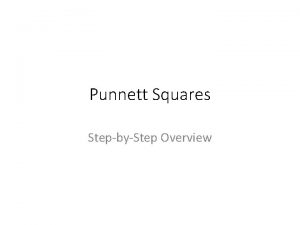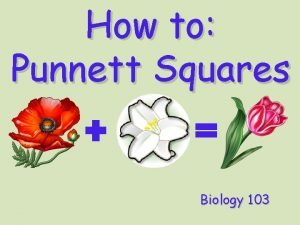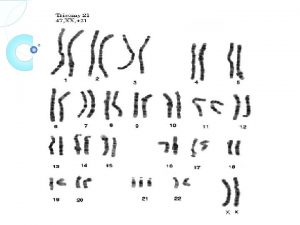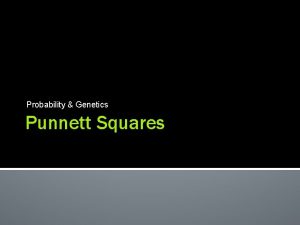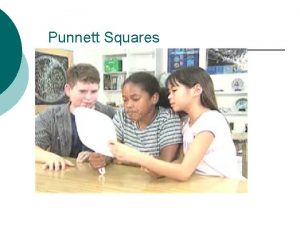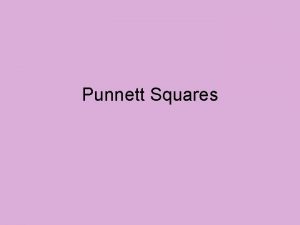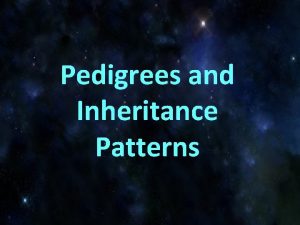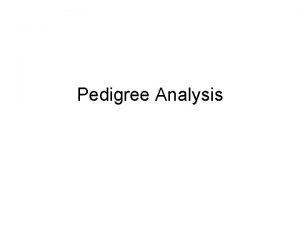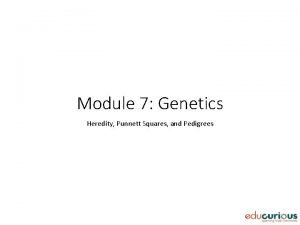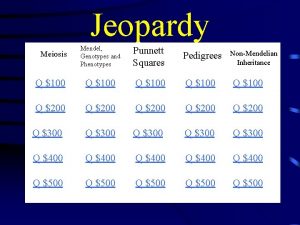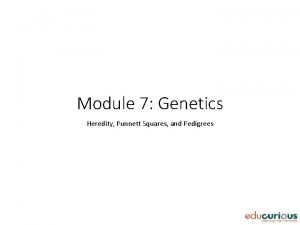Punnett Squares and Pedigrees Unit 5 Reproduction and






























































- Slides: 62

Punnett Squares and Pedigrees Unit 5 Reproduction and Heredity Lesson 5

What’s the Probability? • Humans have a 1 in 2 chance of having a boy or a girl with each pregnancy. If the first child is a girl, what is the probability that the second child will be a girl?

What’s the Probability? • Humans have a 1 in 2 chance of having a boy or a girl with each pregnancy. If the first child is a girl, what is the probability that the second child will be a girl? • 1 in 2.

What’s the Probability? • Humans have a 1 in 2 chance of having a boy or a girl with each pregnancy. If the first child is a girl, what is the probability that the second child will be a girl? • 1 in 2. • The probability of something happening is not affected by what has happened before.

Gender Determination Quick Lab • Let’s do a quick exercise that explains how gender is inherited.

Completing a Punnett Square Quick Lab • Let’s do one more quick lab that shows us how to create a Punnett square and use it to predict the probabilities of genotypes and phenotypes.

Multi-Trait Punnett Squares • Let’s make a Multi-Trait Punnett Square. We have a plant that is homozygous for green seeds (GG) and heterozygous for purple flowers (Ff) crossed with a plant heterozygous for green seeds (Gg) and homozygous for white flowers (ff).

Multi-Trait Punnett Squares • Let’s make a Multi-Trait Punnett Square. We have a plant that is homozygous for green seeds (GG) and heterozygous for purple flowers (Ff) crossed with a plant heterozygous for green seeds (Gg) and homozygous for white flowers (ff). • First, let’s write the genotypes of the two plants.

Multi-Trait Punnett Squares • Let’s make a Multi-Trait Punnett Square. We have a plant that is homozygous for green seeds (GG) and heterozygous for purple flowers (Ff) crossed with a plant heterozygous for green seeds (Gg) and homozygous for white flowers (ff). • First, let’s write the genotypes of the two plants. • GGFf and Ggff

Multi-Trait Punnett Squares • Let’s make a Multi-Trait Punnett Square. We have a plant that is homozygous for green seeds (GG) and heterozygous for purple flowers (Ff) crossed with a plant heterozygous for green seeds (Gg) and homozygous for white flowers (ff). • First, let’s write the genotypes of the two plants. • GGFf and Ggff • Next, write down the possible combinations of alleles that would be in the gametes.

Multi-Trait Punnett Squares • Let’s make a Multi-Trait Punnett Square. We have a plant that is homozygous for green seeds (GG) and heterozygous for purple flowers (Ff) crossed with a plant heterozygous for green seeds (Gg) and homozygous for white flowers (ff). • First, let’s write the genotypes of the two plants. • GGFf and Ggff • Next, write down the possible combinations of alleles that would be in the gametes. • Plant 1: GF, Gf, GF, Gf. Plant 2: Gf, gf, Gf, gf.

Multi-Trait Punnett Squares • First, let’s write the genotypes of the two plants. • GGFf and Ggff • Next, write down the possible combinations of alleles that would be in the gametes. • Plant 1: GF, Gf, GF, Gf. Plant 2: Gf, gf, Gf, gf. • Write these combinations along the top and side of a 16 -cell Punnett square and complete it. What four genotypes will you get?

Multi-Trait Punnett Squares • First, let’s write the genotypes of the two plants. • GGFf and Ggff • Next, write down the possible combinations of alleles that would be in the gametes. • Plant 1: GF, Gf, GF, Gf. Plant 2: Gf, gf, Gf, gf. • Write these combinations along the top and side of a 16 -cell Punnett square and complete it. What four genotypes will you get? • GGFf, GGff, Gg. Ff, Ggff.

Sonnem Farming • What would the genotype of a homozygous, brown-furred long-tailed Sonnem be?

Sonnem Farming • What would the genotype of a homozygous, brown-furred long-tailed Sonnem be? • BBTT

Sonnem Farming • What would the genotype of a homozygous, brown-furred long-tailed Sonnem be? • BBTT • What about a homozygous, white-furred, short-tailed Sonnem?

Sonnem Farming • What would the genotype of a homozygous, brown-furred long-tailed Sonnem be? • BBTT • What about a homozygous, white-furred, short-tailed Sonnem? • bbtt

Sonnem Farming • What would the genotype of a homozygous, brown-furred long-tailed Sonnem be? • BBTT • What about a homozygous, white-furred, short-tailed Sonnem? • bbtt • Let’s do a Punnett square that shows the possible outcomes for this cross. It will be a multi-trait or dihybrid cross.

Punnett Square- Dihybrid Cross • Make a four by four Punnett square. Across the top, have the following: BT, BT, BT. Across the side, have the following: bt, bt, bt.

Punnett Square- Dihybrid Cross • Make a four by four Punnett square. Across the top, have the following: BT, BT, BT. Across the side, have the following: bt, bt, bt. • What will all the offspring be?

Punnett Square- Dihybrid Cross • Make a four by four Punnett square. Across the top, have the following: BT, BT, BT. Across the side, have the following: bt, bt, bt. • What will all the offspring be? • Bb. Tt

Punnett Square- Dihybrid Cross • Make a four by four Punnett square. Across the top, have the following: BT, BT, BT. Across the side, have the following: bt, bt, bt. • What will all the offspring be? • Bb. Tt • If we were to repeat for Straight/Curly ears (SS or ss) and Long/short legs (LL or ll), would we get the same type of results?

Punnett Square- Dihybrid Cross • Make a four by four Punnett square. Across the top, have the following: BT, BT, BT. Across the side, have the following: bt, bt, bt. • What will all the offspring be? • Bb. Tt • If we were to repeat for Straight/Curly ears (SS or ss) and Long/short legs (LL or ll), would we get the same type of results? • Yes, they would all be Ss. Ll.

Interpreting Pedigree Charts Quick Lab • Let’s do one last quick lab that shows us how to use pedigrees to predict patterns of inheritance of a recessive trait.

Introduction • Welcome to the lesson, "Punnett Squares and Pedigrees. " In this lesson, you will learn how patterns of heredity can be predicted by Punnett squares and pedigrees. • EQ: How are patterns of inheritance studied? • The vocabulary words in this lesson are Punnett square, ratio, probability, and pedigree.

Vocabulary • Punnett square: A graphic used to predict the results of a genetic cross • Ratio: A comparison of two numbers using division • Probability: The likelihood that a possible future event will occur in any given instance of the event • Pedigree: A diagram that shows the occurrence of a genetic trait in several generations of a family

Punnett Squares • Look at the Punnett square on page 340 showing the pea flowers. How is the symbol for each allele the same?

Punnett Squares • Look at the Punnett square on page 340 showing the pea flowers. How is the symbol for each allele the same? • Each allele is symbolized by the same letter, F.

Punnett Squares • Look at the Punnett square on page 340 showing the pea flowers. How is the symbol for each allele the same? • Each allele is symbolized by the same letter, F. • How can you tell which allele is dominant and which allele is recessive?

Punnett Squares • Look at the Punnett square on page 340 showing the pea flowers. How is the symbol for each allele the same? • Each allele is symbolized by the same letter, F. • How can you tell which allele is dominant and which allele is recessive? • A capital F is used for the dominant allele, and a lowercase f is used for the recessive allele.

Punnett Squares • Look at the Punnett square on page 340 showing the pea flowers. How is the symbol for each allele the same? • Each allele is symbolized by the same letter, F. • How can you tell which allele is dominant and which allele is recessive? • A capital F is used for the dominant allele, and a lowercase f is used for the recessive allele. • In this Punnett square, which trait is dominant?

Punnett Squares • Look at the Punnett square on page 340 showing the pea flowers. How is the symbol for each allele the same? • Each allele is symbolized by the same letter, F. • How can you tell which allele is dominant and which allele is recessive? • A capital F is used for the dominant allele, and a lowercase f is used for the recessive allele. • In this Punnett square, which trait is dominant? • Purple flowers, F

Punnett Squares • Look at the Punnett square on page 340 showing the pea flowers. How is the symbol for each allele the same? • Each allele is symbolized by the same letter, F. • How can you tell which allele is dominant and which allele is recessive? • A capital F is used for the dominant allele, and a lowercase f is used for the recessive allele. • In this Punnett square, which trait is dominant? • Purple flowers, F. White flowers, f, is recessive. • What does each box show?

Punnett Squares • How can you tell which allele is dominant and which allele is recessive? • A capital F is used for the dominant allele, and a lowercase f is used for the recessive allele. • In this Punnett square, which trait is dominant? • Purple flowers, F. White flowers, f, is recessive. • What does each box show? • The alleles of one possible cross

Punnett Squares • Look at page 341. This Punnett square is showing round and wrinkled peas. What kinds of alleles do both parents have?

Punnett Squares • Look at page 341. This Punnett square is showing round and wrinkled peas. What kinds of alleles do both parents have? • Both parents have one dominant and one recessive allele.

Punnett Squares • Look at page 341. This Punnett square is showing round and wrinkled peas. What kinds of alleles do both parents have? • Both parents have one dominant and one recessive allele.

Punnett Squares • Look at page 341. This Punnett square is showing round and wrinkled peas. What kinds of alleles do both parents have? • Both parents have one dominant and one recessive allele. • What does the dominant allele produce?

Punnett Squares • Look at page 341. This Punnett square is showing round and wrinkled peas. What kinds of alleles do both parents have? • Both parents have one dominant and one recessive allele. • What does the dominant allele produce? • Round peas

Punnett Squares • Look at page 341. This Punnett square is showing round and wrinkled peas. What kinds of alleles do both parents have? • Both parents have one dominant and one recessive allele. • What does the dominant allele produce? • Round peas • What does the recessive allele produce?

Punnett Squares • Look at page 341. This Punnett square is showing round and wrinkled peas. What kinds of alleles do both parents have? • Both parents have one dominant and one recessive allele. • What does the dominant allele produce? • Round peas • What does the recessive allele produce? • Wrinkled peas

Punnett Squares • Look at page 341. This Punnett square is showing round and wrinkled peas. What kinds of alleles do both parents have? • Both parents have one dominant and one recessive allele. • What does the dominant allele produce? • Round peas • What does the recessive allele produce? • Wrinkled peas • What two genotypes (pairs of alleles) will produce a phenotype (physical appearance) of a round pea?

Punnett Squares • Look at page 341. This Punnett square is showing round and wrinkled peas. What kinds of alleles do both parents have? • Both parents have one dominant and one recessive allele. • What does the dominant allele produce? • Round peas • What does the recessive allele produce? • Wrinkled peas • What two genotypes (pairs of alleles) will produce a phenotype (physical appearance) of a round pea? • RR and Rr

Punnett Squares • What does the dominant allele produce? • Round peas • What does the recessive allele produce? • Wrinkled peas • What two genotypes (pairs of alleles) will produce a phenotype (physical appearance) of a round pea? • RR and Rr • What genotype will produce a phenotype of a wrinkled pea?

Punnett Squares • What does the dominant allele produce? • Round peas • What does the recessive allele produce? • Wrinkled peas • What two genotypes (pairs of alleles) will produce a phenotype (physical appearance) of a round pea? • RR and Rr • What genotype will produce a phenotype of a wrinkled pea? • rr

Ratios and Percentages • Ratios and percentages can show the same information but in different ways. For example, if you toss a coin in the air, and there is a 50% chance that the coin will land heads-up, this means that out of 100 times the coin is tossed, it landed heads-up 50 of those times. A ratio expresses this idea too, but it is not necessarily based on 100. A 50% chance that a coin tossed will land heads-up can be expressed as a ratio of 1: 2. The ratio indicates that, on average, the coin will land heads-up one of every two times it is tossed.

Ratios and Percentages • Ratios and percentages can show the same information but in different ways. For example, if you toss a coin in the air, and there is a 50% chance that the coin will land heads-up, this means that out of 100 times the coin is tossed, it landed heads-up 50 of those times. A ratio expresses this idea too, but it is not necessarily based on 100. A 50% chance that a coin tossed will land heads-up can be expressed as a ratio of 1: 2. The ratio indicates that, on average, the coin will land heads-up one of every two times it is tossed. • If there is a 50% chance of having a boy baby, what is the ratio?

Ratios and Percentages • Ratios and percentages can show the same information but in different ways. For example, if you toss a coin in the air, and there is a 50% chance that the coin will land heads-up, this means that out of 100 times the coin is tossed, it landed heads-up 50 of those times. A ratio expresses this idea too, but it is not necessarily based on 100. A 50% chance that a coin tossed will land heads-up can be expressed as a ratio of 1: 2. The ratio indicates that, on average, the coin will land heads-up one of every two times it is tossed. • If there is a 50% chance of having a boy baby, what is the ratio? • 1: 2

Ratios and Percentages • If there is a 50% chance of having a boy baby, what is the ratio? • 1: 2 • If the first child is a girl, what is the probability of the next child being a boy?

Ratios and Percentages • If there is a 50% chance of having a boy baby, what is the ratio? • 1: 2 • If the first child is a girl, what is the probability of the next child being a boy? • 50%

Pedigrees • Look at the pedigree chart on page 344. What do the man and woman have in common in the first generation?

Pedigrees • Look at the pedigree chart on page 344. What do the man and woman have in common in the first generation? • The are both carriers of a trait.

Pedigrees • Look at the pedigree chart on page 344. What do the man and woman have in common in the first generation? • The are both carriers of a trait. • How do you know?

Pedigrees • Look at the pedigree chart on page 344. What do the man and woman have in common in the first generation? • The are both carriers of a trait. • How do you know? • Both are shown as half-shaded, which means they carry the trait.

Pedigrees • Look at the pedigree chart on page 344. What do the man and woman have in common in the first generation? • The are both carriers of a trait. • How do you know? • Both are shown as half-shaded, which means they carry the trait. • In the second generation, who expresses the trait and who carries the trait?

Pedigrees • Look at the pedigree chart on page 344. What do the man and woman have in common in the first generation? • The are both carriers of a trait. • How do you know? • Both are shown as half-shaded, which means they carry the trait. • In the second generation, who expresses the trait and who carries the trait? • The daughter, 4, expresses (has) the trait. Two sons, 2 and 5, carry the trait.

Pedigrees • Look at the pedigree chart on page 344. What do the man and woman have in common in the first generation? • The are both carriers of a trait. • How do you know? • Both are shown as half-shaded, which means they carry the trait. • In the second generation, who expresses the trait and who carries the trait? • The daughter, 4, expresses (has) the trait. Two sons, 2 and 5, carry the trait. • What happens to the trait in the third generation?

Pedigrees • How do you know? • Both are shown as half-shaded, which means they carry the trait. • In the second generation, who expresses the trait and who carries the trait? • The daughter, 4, expresses (has) the trait. Two sons, 2 and 5, carry the trait. • What happens to the trait in the third generation? • One daughter, 3, carries the trait. The other daughter and son are not carriers. No one in this generation has the trait.

Pedigrees • How do you know? • Both are shown as half-shaded, which means they carry the trait. • In the second generation, who expresses the trait and who carries the trait? • The daughter, 4, expresses (has) the trait. Two sons, 2 and 5, carry the trait. • What happens to the trait in the third generation? • One daughter, 3, carries the trait. The other daughter and son are not carriers. No one in this generation has the trait. • What happens to the trait in the fourth generation?

Pedigrees • In the second generation, who expresses the trait and who carries the trait? • The daughter, 4, expresses (has) the trait. Two sons, 2 and 5, carry the trait. • What happens to the trait in the third generation? • One daughter, 3, carries the trait. The other daughter and son are not carriers. No one in this generation has the trait. • What happens to the trait in the fourth generation? • One daughter, 3, is a carrier and one daughter and a son, 1 and 2, have the trait.

Summary • A Punnett square is a diagram that can be used to predict how a trait will pass from two parents to their offspring. • A pedigree is a diagram that shows how a trait is passed down through generations in a family. • Sex chromosomes, and X chromosomes in particular, carry alleles that determine other traits. • Sometimes these traits are associated with disorders.

Description Wheel • For homework tonight, make a description wheel about Punnett Squares and a description wheel about pedigrees. In each, clarify the functions of the Punnett square and pedigree.
 Punnett square
Punnett square How many squares
How many squares Section 11-2 probability and punnett squares
Section 11-2 probability and punnett squares 11-2 probability and punnett squares
11-2 probability and punnett squares 11-2 probability and punnett squares
11-2 probability and punnett squares Gregor mendel punnett square
Gregor mendel punnett square Phenotype percentage example
Phenotype percentage example Damien thiesson
Damien thiesson Sexual reproduction and asexual reproduction
Sexual reproduction and asexual reproduction Pyr
Pyr Sex-linked inheritance punnett square
Sex-linked inheritance punnett square Limitations of punnett squares in large populations
Limitations of punnett squares in large populations Punnet square
Punnet square Dihybrid cross foil
Dihybrid cross foil Ttrr ttrr cross
Ttrr ttrr cross How to foil alleles
How to foil alleles Punnett square eye color hazel
Punnett square eye color hazel Dihybrid punnett square
Dihybrid punnett square Punnett square
Punnett square Sex linkage example
Sex linkage example Biology chart genes
Biology chart genes Dihybrid punnett squares
Dihybrid punnett squares Inheritance
Inheritance Punnett square example
Punnett square example Punic square
Punic square The disadvantages of sexual reproduction
The disadvantages of sexual reproduction Sexual and asexual reproduction venn diagram
Sexual and asexual reproduction venn diagram Pedigrees and karyotypes
Pedigrees and karyotypes Pedigrees and karyotypes
Pedigrees and karyotypes Pedigrees and karyotypes
Pedigrees and karyotypes Pedigrees edpuzzle answers
Pedigrees edpuzzle answers Pedigrees practice ap biology
Pedigrees practice ap biology Practice pedigrees
Practice pedigrees Pedigree practice
Pedigree practice World pedigrees
World pedigrees Unit 17 plant reproduction
Unit 17 plant reproduction Reproduction unit
Reproduction unit Unit 10, unit 10 review tests, unit 10 general test
Unit 10, unit 10 review tests, unit 10 general test The diagonals of rhombus wxyz intersect at v
The diagonals of rhombus wxyz intersect at v Properties of rhombus rectangle and square
Properties of rhombus rectangle and square Least squares solution
Least squares solution Conditions for rhombuses rectangles and squares
Conditions for rhombuses rectangles and squares 6-4 properties of rhombuses rectangles and squares
6-4 properties of rhombuses rectangles and squares Theorem of rectangle
Theorem of rectangle 6-5 special parallelograms rhombi squares
6-5 special parallelograms rhombi squares Difference of two squares examples
Difference of two squares examples 4th root of 1296
4th root of 1296 Most specific name for quadrilateral
Most specific name for quadrilateral Properties of rhombuses
Properties of rhombuses Square
Square Lesson 15-4 rectangles rhombuses and squares
Lesson 15-4 rectangles rhombuses and squares Lesson 15-4 rectangles rhombuses and squares answers
Lesson 15-4 rectangles rhombuses and squares answers 6-5 skills practice rhombi and squares
6-5 skills practice rhombi and squares Draw two congruent squares
Draw two congruent squares 6-5 homework rhombi and squares
6-5 homework rhombi and squares What is ambiguity in semantics
What is ambiguity in semantics How do you determine if the situation involves permutation
How do you determine if the situation involves permutation Solids with known cross sections
Solids with known cross sections 12 and 20 gcf
12 and 20 gcf Evaluate square root
Evaluate square root How to evaluate a square root
How to evaluate a square root Square binomial
Square binomial Square and square root from 1 to 20
Square and square root from 1 to 20
